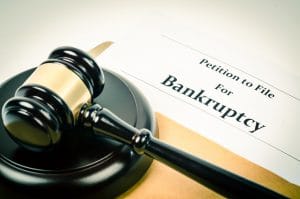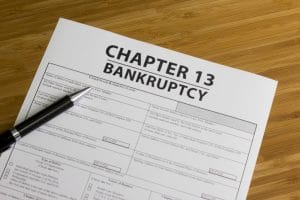Declaring bankruptcy sounds overwhelming and scary, but it’s often the only option left for those who are in a difficult financial situation. To help inform you, we’re going to discuss how you can declare bankruptcy and also explain what you should expect when you do so.
Before resorting to declaring bankruptcy, it’s a good idea to speak with a financial advisor and/or an experienced attorney that can help you through the process and help you decide if declaring bankruptcy is the right move for you.
Chapter 7 Bankruptcy or Chapter 13 Bankruptcy?
Residents of Kansas have two types of bankruptcy that they can file for: Chapter 7 or Chapter 13.
Depending on your financial circumstances and your reason for declaring bankruptcy, it’s important to understand the differences between the two.

There are a couple of situations where a chapter 13 filing is preferable to Chapter 7.
Chapter 13 bankruptcy is the only choice available if you are struggling with your mortgage or business payments, but want to keep your property.
Chapter 13 allows you to make up your overdue payments over time and also reinstate the original mortgage agreement. Chapter 13 filing is also usually the only choice if you have too much income to file a Chapter 7 bankruptcy, or if you have debt that is non-dischargeable in a Chapter 7 filing (such as specific taxes).
Most residents of Kansas will opt for a Chapter 7 bankruptcy if they want to eliminate their debt and stabilize their finances. There is no minimum amount of debt required or an income limit when it comes to filing Chapter 7 bankruptcy.
A Chapter 7 filing allows you to start fresh once the bankruptcy is discharged and the only debt you owe will be for secured assets which you choose to sign with a Reaffirmation Agreement.
You’ll also have immediate protection against any collection efforts and wage garnishment on the date of the filing. Any property you acquire and wages you earn will also be yours to keep once the bankruptcy filing date has passed instead of going to creditors or the bankruptcy court. The case is often over within 3 to 6 months.
It’s worth keeping in mind that even if you are able to file for Chapter 7 bankruptcy, it’s not always the best option.
In general, Chapter 7 bankruptcy is better if you’re not attempting to keep secured property, such as a home with a mortgage. It’s best to speak with your attorney and/or credit counselor to help you decide what the best option is.
Recommended Read: A Look at the Pros and Cons of Filing for Bankruptcy
The Kansas Bankruptcy Process

1. Find a Credit Counselor
The 2005 Bankruptcy Act requires that all debtors who file bankruptcy on or after October 17, 2005, must seek credit counseling.
This must happen within six months of your filing for bankruptcy relief, and you’ll be required to undergo a financial management instructional course once the bankruptcy is discharged.
Credit counselors work with debtors to improve their financial situation. The process can include offering tools, resources, and education to help you control your incoming and outgoing money.
This service is typically offered to people that are in difficult financial situations but can also be applicable to those who are seeking debt counseling, house and mortgage counseling, and more.
In short, it’s required that you seek out a qualified and trustworthy financial advisor to help you undergo the credit counseling process.
2. Examine Your Income
Your income needs to be analyzed before you can continue with your bankruptcy filing. The first thing that the court will check is your average income.
They will examine your average income over the last 6 months and compare it to the median income for residents of Kansas.
If you are over the median income limit as of now, it may be worth waiting longer to bring your average income down below the median level for Kansas.
If your income is below the median, then you have the option of picking a Chapter 7 bankruptcy filing.
If your income exceeds the median, then you will need to take more tests to determine if you are eligible for a Chapter 7 filing.
The means test requires that you gather information needed to complete certain calculations. These are usually always from your own personal records. You’ll need to provide proof of your income from all sources you have.
This can include rental income, business income, interest, dividends, pensions and so on. There are a few actual expenses that are allowed to be included in the calculation, such as expenses that are necessary for health and welfare.
Your credit counselor will help you through the steps of taking and passing the means test so you’re eligible for Chapter 7 bankruptcy. If your income is too high, then you will need to file for Chapter 13 bankruptcy instead.
3. Gather Your Paperwork
Before filing for bankruptcy, it’s important to itemize your current income sources. This includes any major financial transactions for the past two years, living expenses, debts, property, assets and also tax returns.
This paperwork should ideally be physically printed or copied (original documents are preferred) and they should be categorized to make it easier to sort through.
Your credit counselor will help you itemize your paperwork to make it more easily presentable. If you’re unable to secure certain paperwork because you’ve lost it or it’s become damaged, you’ll need to speak to those sources (such as your bank or mortgage lender) to request the documents.
4. Filing for Bankruptcy
Once you’ve compiled the paperwork required to file for bankruptcy, you can initiate the process.
This is often done with the help of an attorney. You should also be determining which property you believe is exempt from seizure based on the Kansas exemptions.
Assets such as insurance, a homestead, and business partnerships may be exempt in addition to certain federal exemptions. If you are currently married, then bankruptcy laws allow you and your partner to each claim a full set of exemptions unless otherwise noted.
Recommended Read: Exempt Assets for Bankruptcy in Kansas
Filing requires either you or your attorney to complete a two-page petition and other forms at your Kansas district bankruptcy court.
These forms are referred to as the schedules and you’ll be asked to describe your current financial situation and provide proof of your recent financial transactions over the past two years. This is where the paperwork that you collected previously will come in handy.
If your creditors feel that you haven’t been completely honest regarding your bankruptcy filing, then they may close your case. It’s important to bring ample amounts of evidence to support your bankruptcy filing. Your attorney and/or credit counselor will help you determine how much information you need in order to have a successful bankruptcy filing.
You will also need to pay a fee of $306 for a Chapter 7 bankruptcy filing. This fee may not be waived, but you may be able to pay it in installments. There is a fee of $281 for a chapter 13 filing that cannot be waived.
5. Chapter 13-Specific Requirements

When filing for Chapter 13 bankruptcy, you must submit a proposed repayment plan.
You’ll need to discuss this with your credit counselor and attorney to determine how much money you have leftover to put towards your outstanding bills after your reasonable monthly expenses.
Priority claims like child support and taxes must be paid in full while credit card debt and medical bills are often paid in part.
Repayment plans must also be delivered in good faith and unsecured creditors must be paid at least as much as if a Chapter 7 bankruptcy had been filed. All disposable income must also be paid into the plan for at least three years.
To meet these payments, you and your attorney will need to have discussions with the court and arrange to have it taken out of your wages.
6. Initiating an Automatic Stay
Once your paperwork has been filed, an automatic stay comes into effect. This prevents creditors from making direct contact with you or staking a claim on any of your property from the day you filed. This will stop foreclosure proceedings and also protect you against collection efforts.
7. Court Assumes Legal Control
Once your bankruptcy claim is filed, the court assumes legal control of your debts and properties that are not covered by the Kansas exemptions.
A trustee will then be appointed to your case by the court. Their job is to see that creditors are paid as much as possible while also reviewing your paperwork on a regular basis.
8. 341 Meeting of Creditors
A month after filing, the trustee will arrange for a meeting with creditors which the debtor must attend.
Creditors will typically only attend a Chapter 13 bankruptcy meeting and will rarely attend a Chapter 7 bankruptcy meeting. This meeting is short and is usually only required to clear up any outstanding concerns regarding your bankruptcy filing.
9. Plan Confirmation
Once the meeting has concluded, creditors will have 60 days to challenge your right to discharge. If there are no challenges, you’ll receive a notice from the court in 3 to 6 months that your dischargeable debts have been removed.
You’ll also need to attend a hearing before a bankruptcy judge if you have filed a Chapter 13 plan. The judge will then confirm or deny the repayment plan.
Filing for bankruptcy isn’t something anyone plans on doing, but it also isn’t the end of the world.
Bankruptcy is a complex and challenging process and it is best done with an experienced attorney who understands the process inside and out.
Contact the knowledgeable bankruptcy attorneys at Oswald Law by calling 620-662-5489 today to schedule your bankruptcy consultation and start your journey towards financial stability.
